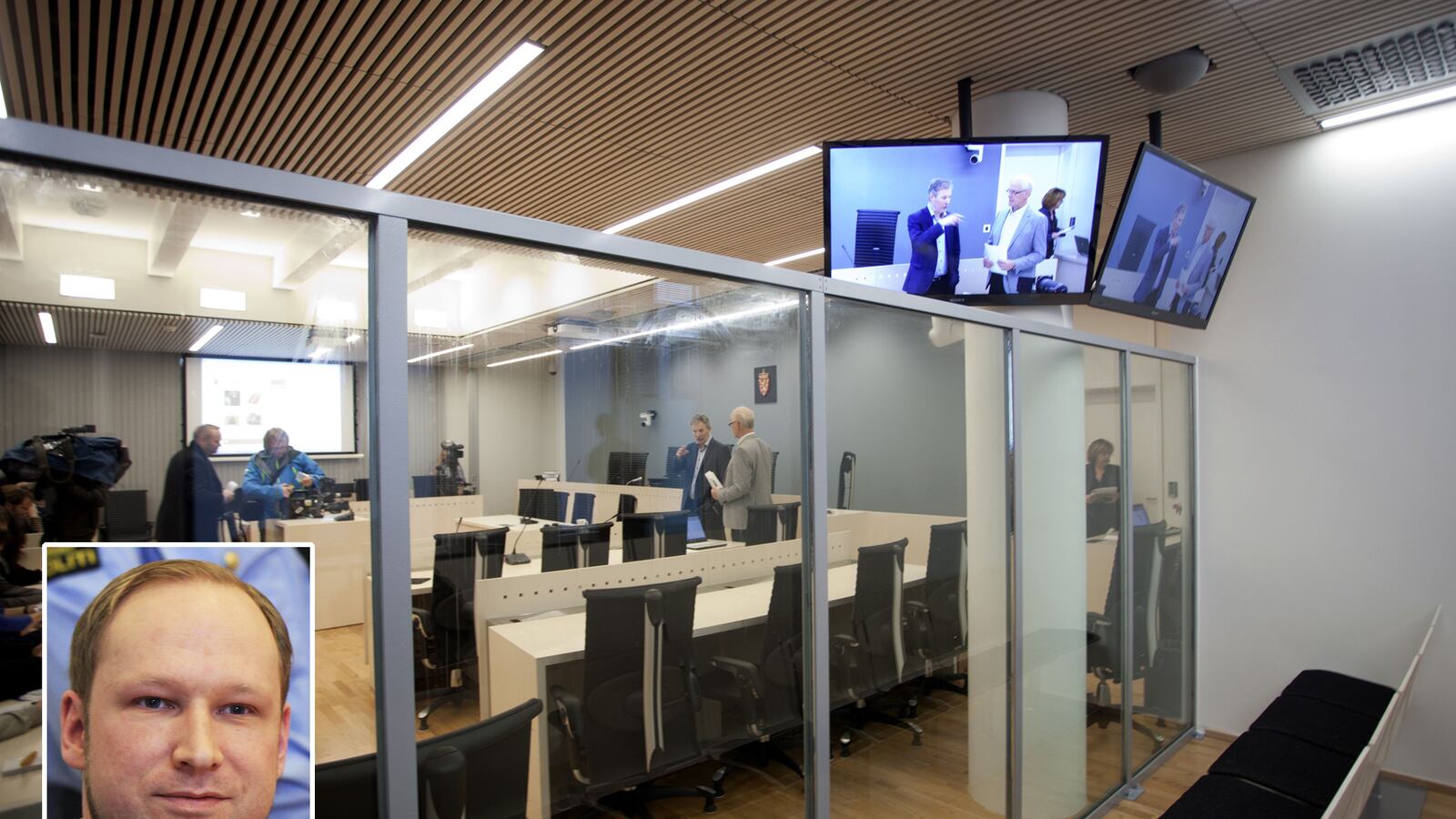The dress rehearsal was about to start. The atmosphere was laid back as groups of jittery spectators entered the hall, the first ones to arrive going for the choice seats in front. Gradually the rows behind filled up. Some found themselves behind a pane of bulletproof glass, others behind white roof-supporting columns. The public observers were overwhelmingly male, most of them in jeans and grayish blazers. A group of conformists, one might say, with the same kind of background, similar sets of experiences. Some of the old-timers had the facial expressions of those who feel they’ve seen it all. A well-known critic sat right next to the stage, draped around his seat like a well-fed lion, yet looking alertly around. Some baby-faced young guys were lined up by the wall, waiting to report live from the scene.
The seats were comfortable in the spanking-new hall. Time for the show to get rolling. This dress rehearsal featured stand-ins in all the lead roles. A young court press officer was picked to play the defendant. The camera honed in on his smooth skin, and he performed unconstrained. A distinguished, graying gentleman who could easily have been cast as Gogol’s Government Inspector tested the microphones while informing what all in the audience should know.
“Are there any non-Norwegian speakers?” shouted a broad-shouldered man from the court administration.
“Try posing that question in English,” suggested one of the denim-clad spectators. Some hands were raised, thus the translating service could be tested, too.
Describing this as a “performance” borders on indecency, of course. This is a trial, the largest one in Norway since the aftermath of the Second World War. Starting in Oslo on April 16th, it will shed light on the act of terror performed by Anders Behring Breivik last July 22.
The trial has already given the perpetrator all he dreamed of. Everything seems to be ticking nicely along according to his plan: a stage, a pulpit, a spellbound, notebook-clutching, pencil-wielding audience. He will admittedly be standing with his back to the spectators because, after all, it is the judges who will sentence him, not the crowd. But Breivik does not care about the sentence, which he knows will be the longest one available by Norwegian law. He does not deny having killed 77 people in one single day.

What he cares about is getting his message across, getting his ideology reported, printed, emailed, and twittered to the masses. Breivik even said as much in his manifesto “2083—A European Declaration of Independence,” using home-spun acronyms to imply that both Europe and the U.S. were in fact Soviet-stye socialist republics: “A trial is an excellent opportunity and a well-suited arena to publicly renounce the authority of the EUSSR/USASSR hegemony and the specific cultural Marxist/multiculturalist regime.” According to Breivik, Western leaders have all sold out to the Arab world, and Islam will soon rule the world. It is against this that he is waging his war, which justifies the killing of the employees of the government area in Oslo and the youth of the Labour Party at the island Utøya.
A man on the back row clears his throat and says:
“I just want to make a statement.” He gets up, a thick-set, dark-haired man. “I am the only journalist from the Arab world. And I don’t have a seat in the main hall.”
The list of accredited journalists for the trial confirms this. There are 200 seats in the main hall, shared among the victims, their relatives, witnesses, and reporters. Those reserved for journalists go to media outlets like CNN and The New York Times. The Chinese news agency Xinhua is the only non-Western on the list as Al Jazeera English is defined as an international news agency, not an Arab one. The rest have been allotted the 600 other seats for journalists in various other venues in Oslo, where the trial will be transmitted by video.
“The arrangement of the seating is final,” the district attorney in the judge’s seat had already informed the crowd. “No discussion.”
Though, the recurring theme in Breivik’s manifesto is his belief in a conspiracy consisting of the European leaders and Muslim/Arab entities. Islam, as he describes it, is evil. Muslims, and by default most Arabs, are to be swept out of Norway. These are views he will promote during the 10-week trial. He wishes to provide theories and proof that Europe is on its way to succumb to Islam. He wants to recruit fellow travelers in his patriotic, nationalistic resistance movement, a struggle which will start with attacking the main traitors, cultural Marxists, the ruling Labour Party of Norway. He says in his manifesto: “When a pipe in your bathroom springs a leak and the water is flooding, what do you do? You go to the source, there is no point mopping up until you have fixed the actual leak. Our regime is the leak, the Muslims the water.”
His mass murder was directly motivated by a wish to gain a pulpit to promote his ideology. The dilemma is obvious. How easily has he not been handed his megaphone, all in the name of freedom of speech and rule of law? Do we increase his importance in this way, subsidizing him, even, to the tune of $2 million a week? Are we puppets on a string, or are we doing what’s right and necessary?
There have been two psychiatric reports on Breivik. The first one was released while I was on assignment in Tripoli, Libya. Its verdict: Breivik was insane, unaccountable for his crimes. In the Norwegian criminal system, one can not be punished for crimes where one does not realize their implications and consequences.
Could Norway accept this? Letting a mass murderer off the hook and offer him treatment as a psychiatric case?
At the time I was delving into Gaddafi’s brutality toward his own people. Would he too have been considered insane, unaccountable for his crimes, by Norwegian court psychiatrists? Would Saddam Hussein? What about Osama bin Laden, or the Muslim suicide bombers in London? Surely, their paranoid, schizophrenic personalities would be obvious? So they couldn’t have been held accountable either, by Norwegian standards?
The uproar was sufficiently strong for Oslo City Court to commission a new report by new experts. They worked more thoroughly, with a larger team who surveilled Breivik around the clock. Their verdict came this week: Sane. Accountable.
The first report was welcomed by many whose views on Islam overlapped or bordered those presented by Breivik in his manifesto. Breivik himself prefers the second one. He wants to spread his message, and not be considered insane. He has this in common with his main opponents: they want to turn this into a political trial.
The defendant and his lawyers want to prove that his views have broad support in Europe, and a number of critics of Islam and of immigration have been summoned as witnesses. Breivik operated on his own, but did not live in a vacuum. He had contacts who shared his views. In his mind, he simply put into action the opinions of his confederates on Internet chatrooms.
Ah, my beloved, boring country which I have left at every opportunity. Other cultures have always drawn me to them, other religions, larger conflicts. I have always observed others, never my own society. But suddenly the ugly face of world affairs showed itself in my living room window. The clash of cultures I have always covered abroad, suddenly popped up a home.
Which is why I will be in courtroom 250 in Oslo Courthouse for the next 10 weeks.
I have always had the opinion that all societies need the gaze from outside to move on, to develop. It can offer perspectives to counter myopia.
So on my way out after the dress rehearsal, walking between the jeans and the gray blazers, I stopped the court press officer who waited by the stairs.
“Please, give the Arab a seat,” I asked.
We need his gaze. On Breivik. On us.






